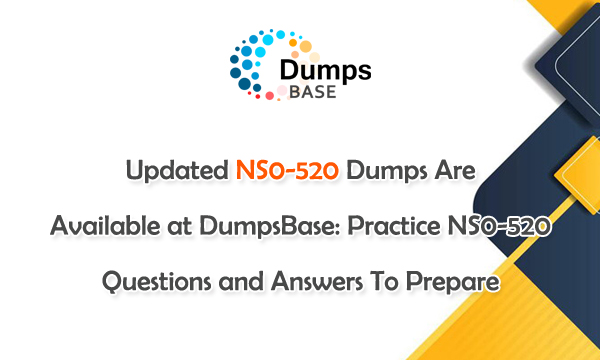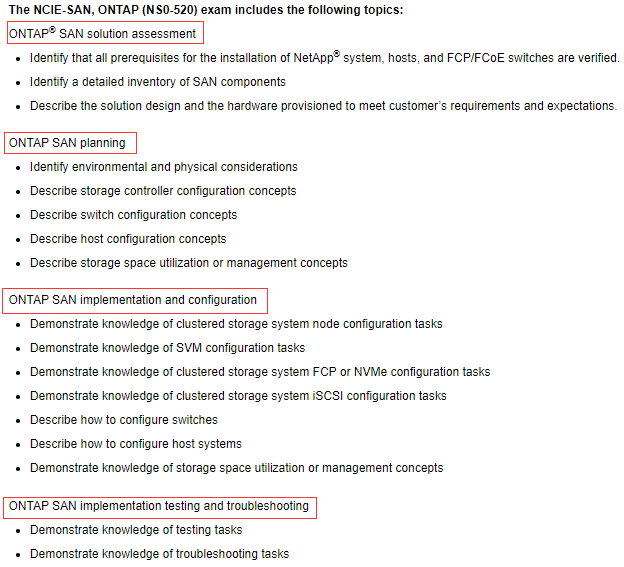Updated NS0-520 Dumps Are Available at DumpsBase: Practice NS0-520 Questions and Answers To Prepare
DumpsBase is a leading provider of exam dumps and study materials. We recently updated our NS0-520 dumps to V12.03, which includes 371 exam questions. To prepare for the NS0-520 NetApp Certified Implementation Engineer - SAN, ONTAP exam, we recommend using our NS0-520 dumps to practice all these questions and answers in pdf format and testing engine. Our Network Appliance NS0-520 exam dumps are designed to help you prepare for the exam and ensure that you pass it successfully. With our dumps, you will be able to practice and prepare for the exam in a real exam environment, which will help you feel confident on exam day.

Why do we choose to pass the NS0-520 exam and be a NetApp Certified Implementation Engineer - SAN, ONTAP certified?
As a demanded Network Appliance certification and exam, the NetApp Certified Implementation Engineer - SAN, ONTAP NS0-520 will be your great choice for enhancing yourselves. The NS0-520 exam is a requirement for the NetApp Certified Implementation Engineer - SAN, ONTAP certification. It is designed to validate that you have proven skills in planning, implementing, integrating, and troubleshooting ONTAP SAN, FC switched fabrics and Ethernet iSCSI/FCoE solutions, and different operating systems (Windows, LINUX, ESX, UNIX) and applications. In order to take this exam, you will need to complete the NS0-162 NetApp Certified Data Administrator, ONTAP exam as a prerequisite.
NS0-162 NetApp Certified Data Administrator, ONTAP
The NS0-162 NetApp Certified Data Administrator, ONTAP exam is a popular Network Appliance certification exam, which proves you have proven skills in performing in-depth support, administrative functions, and performance management for NetApp® data storage controllers running the ONTAP® operating system in NFS and Windows® (CIFS) multiprotocol environments. Passing the NS0-162 exam will make you understand how to implement high-availability controller configurations, and have detailed knowledge of technologies used to manage and protect mission-critical data. The same as NS0-520 dumps, we DumpsBase also have updated the NS0-162 exam dumps to V14.03 with 379 practice exam questions and answers. You can prepare for your NS0-162 exam well with our valid dumps today.
NS0-520 NetApp Certified Implementation Engineer - SAN, ONTAP
The real NS0-520 exam consists of 60 multiple-choice questions, and you will have 90 minutes to complete the exam. The candidates for the NS0-520 exam are recommended to have six to 12 months of experience in planning, implementing, and validating end-to-end SAN solutions for customers in FC and iSCSI environments. Experience in SAN implementation within virtualized environments and within clustered environments is highly recommended.

Our NS0-520 dumps cover all the topics that are included in the exam, and they are updated regularly to ensure that they are accurate and up-to-date. With our NS0-520 dumps, you will be able to practice and prepare for the exam in a real exam environment, which will help you feel confident on exam day.
Check NS0-520 Free Dumps Demo Before Downloading Updated NS0-520 Dumps
What is the recommended minimum of data LIFs per node for iSCSI in a dual-fabric configuration with four SVMs?
A. 8
B. 12
C. 16
D. 4
Answer: A
Which Data ONTAP option sets system-wide throttling for all transfers?
A. options transfer.wide.enable
B. options transfer.throttle.enable
C. options replication.wide.enable
D. options replication.throttle.enable
Answer: B
An administrator is migrating from a third-party's SAN to a newly purchased FAS9000. The administrator decides to use the NetApp Foreign LUN Import (FLI) process.
What must the administrator do for this process to work properly?
A. Create multiple igroups for the Initiator ports.
B. Create six distinct zones that include specific ports within each zone.
C. Zone target ports of source storage with initiator ports of destination storage.
D. Make the destination LUN larger than the foreign LUN.
Answer: C
When using a Protection Manager policy to manage Open Systems SnapVault backups on a UNIX server, which three are valid objects to include in the data set? (Choose three.)
A. A file
B. A qtree
C. A directory
D. Theentire client
Answer: ABC
You have an SVM that serves LUNs to your hosts in an FC SAN environment. This SVM runs on a 4-node cluster and has two data LIFs on each node, according to best practices. You just created a LUN and mapped it to your initiators group. The LUN is owned by node01.
In this scenario, what would be an appropriate test for LUN mobility?
A. Move the LUN to node02.
B. Mirror the LUN to another node in your cluster.
C. Physically disconnect the SAN ports, and verify if the SAN data LIFs automatically move to other hosts.
D. Copy the LUN to another node and create a new LUN map.
Answer: A
A company has 20 ESX hosts. Ten of the hosts are connected using FC, and the rest are connected over iSCSI. The FC host HBA queue depth is set to 32, and the iSCSI LUN queue depth is set to 64. The FC hosts are now experiencing random connectivity issues.
In this scenario, what would be the reason for the disconnects?
A. The FC host has a lower queue depth.
B. According to the IMT, unsupported HBA firmware is in use.
C. All of the hosts are part of the same cluster.
D. The queue depth is not consistent across the cluster.
Answer: B
A 4-node ONTAP FAS9000 cluster was used to serve I/O from six RedHat 7.3 servers. The servers were configured with maximum, queue depth.
For production purposes, an additional 60 similarly configured hosts were added to the environment. Later, the hosts started reporting random QFull errors, and the aggregated performance degraded.
Which two solutions would alleviate the QFull errors and performance problems? (Choose two.)
A. Remove Selective LUN Mapping (SIM) from the 4-node FAS9000 cluster.
B. Download the latest FC HBA driver, firmware, and BIOS, and deploy them on the hosts.
C. Configure and use additional FC target HBAs in the FAS9000 cluster.
D. Reduce FC HBA gueue depth on the hosts.
Answer: CD
Which two scenarios in deploying ONTAP Cloud are supported by the Cloud Manager tool? (Choose two.)
A. ONTAP Cloud deployed as an HA pair on IBM Cloud
B. ONTAP Cloud deployed as an HA pair on VMware
C. ONTAP Cloud deployed as a single instance on Microsoft Azure
D. ONTAP Cloud deployed as an HA pair on Amazon Web Services
Answer: CD
You need to configure iSCSI on your existing ONTAP cluster in a new SVM. The iSCSI LUNs will be served over a new Layer 2 network using the same physical ports that also use the CIFS protocol on a different SVM.
Which two actions should you perform to accomplish this task? (Choose two.)
A. Create a new portset.
B. Create a new VLAN.
C. Create a new broadcast domain.
D. Create a new AD object.
Answer: BC
Which command disables client access to Snapshot copies on a volume called flexvoll?
A. cifs shares-change flxvoll-nosnap
B. snap access flexvoll off
C. vol options flexvoll nonsnapdir on
D. vol options flexvoll snapdir off
E. vol options flexvoll snapdir on
Answer: C
A customer is planning to connect a Linux server to a FAS8200 using Brocade FC switches. During the initial configuration, the SVM does not log in to the fabric.
Which two statements are correct in this scenario? (Choose two.)
A. NPIV has not been enabled on the switches.
B. The switch port topology is set incorrectly to the E_Port.
C. ALUA has not been set up on the FAS8200.
D. Zoning is incorrectly configured between the Linux server and the ONTAP cluster.
Answer: AD
You plan to use Foreign LUN Import (FLI) to migrate data from an older storage array to an ONTAP cluster. You have properly cabled the storage array and the NetApp nodes to your dual-fabric SAN.
Which two steps are required for this migration and cutover? (Choose two.)
A. Add NetApp WWN initiator ports to the existing zones.
B. Add NetApp WWN target ports to the existing zones so that your hosts can access both storage arrays.
C. Create two zones that contain the NetApp target ports and the host initiators ports, one for each fabric.
D. Create two zones that contain NetApp initiator ports and the source storage target ports, one for each fabric.
Answer: AD
